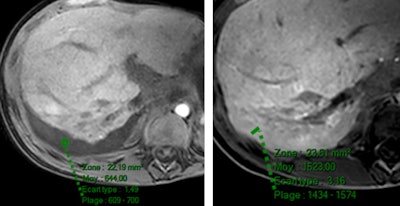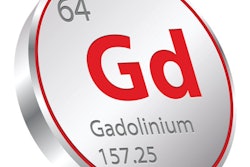
Hypersignal seen outside the liver parenchyma on MRI scans after an injection of contrast for hepatobiliary studies is usually understood as a sign of biliary leak. But is it a good way to confirm injury after surgery or trauma? Maybe not, according to the researchers of a study to be presented on Saturday at the Journées Francophones de Radiologie (JFR 2017) congress.
Dr. Maxime Ronot, liver and abdominal radiologist at Beaujon University Hospital, will present the results of his study on fluid enhancement after injection of hepatospecific contrast agents on Saturday in the scientific session on abdominal imaging at JFR 2017.
His study has revealed that signal around the liver on MRI is not always indicative of a leak, and choice of contrast agent impacts the reliability of leak diagnosis.
Mysterious hypersignal
Ronot first became aware of the discrepancy when over a short period of time he noticed three cases of white liquid around the liver on MRI scans, suggesting a leak. Further investigation revealed there was no leak in any of the three patients, which prompted him to conduct a retrospective study into why such hypersignal was depicted. He was aided by a medical resident from Italy who was able to provide some MRI scans from the Sapienza University hospital in Rome.
 Dr. Maxime Ronot.
Dr. Maxime Ronot.In total, Ronot reviewed 139 abdominal hepatospecific contrast-enhanced MRI scans (62 from Beaujon hospital and 77 from Sapienza hospital) taken between 2015 and 2016, which only used hepatospecific contrast agents and showed any amount of peritoneal or pleural fluid.
The 139 scans were divided equally between those from patients injected with MultiHance (Gd-BOPTA) and those injected with Primovist (Gd-OB-DTPA). Half of the scans within each contrast agent category were performed at 1.5 tesla and the other half at 3 tesla. A range of different disease and clinical contexts was represented across each of the four groups.
Two radiologist readers interpreted the scans qualitatively and quantitatively on precontrast, dynamic, and hepatobiliary phases. Qualitatively, fluid was described as hypointense in the hepatobiliary phase with Primovist, while it was hyperintense with MultiHance. When quantitatively measured, fluid signal intensity increased with both MultiHance and Primovist, but it was significantly more marked after MultiHance.
"Within the four groups we looked at what happened in the hepatobiliary phase. Nearly all the patients injected with MultiHance had iso- or hypersignal intensity of the fluid, but this was not true of those injected with Primovist," Ronot told AuntMinnieEurope.com ahead of the meeting.

Ronot believed the key lay in the time delay between injection and acquisition. With Primovist, the time delay is usually 20 minutes, but with MultiHance it is 1.5 to two hours, allowing more time for contrast agent accumulation in the fluids.
To test his theory, he looked at scans of patients injected with Primovist but for whom acquisition had taken place later than usual. Three scans were found for which acquisition had taken place around 45 minutes after injection, and these showed some significant enhancement of fluids.
"If you inject hepatospecific contrast agents there will be some degree of fluid enhancement but this is generally not seen with Primovist because the time from injection to image acquisition is too short. Time to acquisition with MultiHance on the other hand is long enough to see the enhancement," Ronot said.
His message to delegates is clear. To diagnose a suspected bile leak, use Primovist, not MultiHance. Conversely, when enhanced fluid can be seen around the liver after an injection of MultiHance, don't automatically assume it is a bile leak.
| Qualitative image analysis | ||||
| BOPTA peritoneal | EOB peritoneal | |||
| 1.5 tesla | 3 tesla | 1.5 tesla | 3 tesla | |
| N (%) | 44 | 43 | 23 | 25 |
| Precontrast hypointensity | 44 (100) | 42 (98) | 23 (100) | 25 (100) |
| Precontrast isointensity | 0 (-) | 1 (2) | 0 (-) | 0 (-) |
| Precontrast hyperintensity | 0 (-) | 0 (-) | 0 (-) | 0 (-) |
| 3 minutes phase hypointensity | 44 (100) | 43 (100) | 23 (100) | 25 (100) |
| 3 minutes phase isointensity | 0 (-) | 0 (-) | 0 (-) | 0 (-) |
| 3 minutes phase hyperintensity | 0 (-) | 0 (-) | 0 (-) | 0 (-) |
| HBP hypointensity | 5 (12) | 0 (-) | 23 (100) | 25 (100) |
| HBP isointensity | 8 (18) | 5 (12) | 0 (-) | 0 (-) |
| HBP hyperintensity | 31 (70) | 38 (88) | 0 (-) | 0 (-) |
Ronot said his study is important, because as far as he knows, this is the first time the problem has come to anyone's attention. Furthermore, Italian colleagues have indicated anecdotally they use MultiHance regularly and this finding of enhanced fluid around the liver without cause is a common occurrence.
In France, legally there is no market access yet to Primovist, even if elsewhere Primovist is the more commonly used contrast agent.
"Due to regulations, French radiologists always use MultiHance," Ronot noted. "Primovist can only be used in trials and for studies, which is perhaps why the discovery of fluid enhancement with MultiHance in the hepatobiliary phase when there is no leak has been revealed for the first time as an issue in France, rather than elsewhere," he concluded.
Session details: Saturday 14 October from 14h00 to 15h30; Room Maillot - Level 2, Palais des Congrès.
Session : Séance scientifique en imagerie abdominale, du pancréas, du tube digestif et des voies biliaires
Presentation : Effet de l'injection de produit de contraste hépatospécifique sur l'intensité de signal des liquides péritonéaux et pleuraux en IRM -- Dr. Maxime Ronot.



















